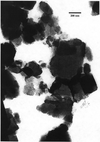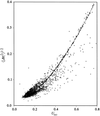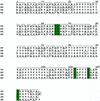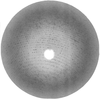issue contents
March 1998 issue

Cover illustration: The balhimycin dimer, with citrate and acetate ions in the binding pockets, colour coded on a scale where the most mobile atoms are red and the least mobile are blue. The binding pockets are clearly the most mobile, consistent with the idea that they can open and close to complex with cell-wall binding peptides. Courtesy of George Sheldrick.
research papers
A phasing algorithm is presented for combining multiple wavelength anomalous dispersion (MAD) data from multiple types of anomalous scatterers, either in the same or in different derivative crystals, as well as for combining MAD data with multiple isomorphous replacement data from different derivative crystals.
Download citation


Download citation


Balhimycin, a glycopeptide antibiotic related to vancomycin, crystallizes with two independent antibiotic dimers and a variety of solvent molecules in a unit cell similar in size to that of a small protein. In each dimer, one binding pocket is occupied by a citrate ion and the other by an acetate.
This paper presents an overview of coding and lossy compression techniques applied to diffraction patterns. Time-frequency analysis, and more specifically wavelet based transform, are proved to induce very low distortion on diffraction peaks for compression rates up to 10.
Diffraction geometry of stationary crystals illuminated by a convergent X-ray source from a polycapillary optic, and its application in macromolecular crystal data collection.
Combination of X-ray amplitudes with phases derived from electron microscopy of thin three-dimensional crystals, allowed the determination of a preliminary low-resolution model of the arginine repressor/activator.
Size and charge microheterogeneities, present in most lysozyme preparations as a result of oxidation, strongly affect crystallization.
A re-determination of this protein structure was carried out using direct methods based on 130 known triplets. Information on triplet phases and on partial structure was combined and used extensively in several cycles of phase refinement and expansion following the initial E map to accomplish a structure solution with data at 2.0 Å resolution.
Estimated standard deviations (e.s.d.'s) of the coordinates for two protein structures are calculated by inversion of the full normal equations matrix during least-squares refinement. The e.s.d.'s are analysed with respect to the atomic U values and deviations of bond lengths from target distances.
Structures of Pseudomonas putida azurin in two polymorphs, one crystallized in the presence and one in the absence of zinc acetate, have been determined at 1.60 and 1.92 Å resolution, respectively. The protein forms nearly identical dimers in both asymmetric units which differ in relative monomer orientation from dimers of other known azurins; chelation of one of the zinc ions by a twofold-related pair of molecules explains the observed change in lattice parameters upon zinc incorporation.
crystallization papers
Crystallization of the NAD+-dependent phenylalanine dehydrogenase from Nocardia sp239 in the presence and absence of co-factor and substrates.
Two crystal forms of tetanus neurotoxin C fragment, the receptor binding sub-unit, have been obtained. Both forms belong to space group P212121 but they possess different unit-cell dimensions and crystal morphologies.
Crystals of the α-hemolysin heptamer, a transmembrane channel from Staphylococcus aureus, have been grown in the presence of the detergents decyldimethyl- and decyldiethylphosphine oxide. Five crystal forms werre obtained, one of which belongs to the space group P1 and diffracts to 3 Å resolution.
Chondroitinase AC from Flavobacterium heparinum, a glycosaminogycan lyase, has been crystallized by the vapor-diffusion method using polyethylene glycol as a precipitant. Crystals belong to P43212 space group and diffract to better than 2.5 Å resolution.
PAPS reductase from E. coli could be crystallized and preliminary X-ray diffraction studies have been carried out. The enzyme is involved in sulfate reduction, which is the source of reduced sulfur for all sulfur-containing metabolites.
Crystals of cytochrome c′ from Rubrivivax gelatinosus obtained at pH 5, 6.3 and 8 diffract, respectively, to 2.0, 1.4 and 1.3 Å using synchrotron radiation and cryogenic conditions. Data (99.8% completeness) collected on a crystal grown at pH 8 allowed the determination of the space group (P3121 or P3221) and the unit-cell parameters (a = b = 69.63, c = 123.63 Å).
book reviews
Free 



 journal menu
journal menu



































